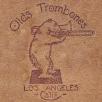
It's a bear!
Medium-Bore Williams TIS with F-attachment
Bore: .522" (13.3 mm), .554” (14.1 mm) attachment
Bell: 9” (228.6 mm)
Although it's not an Olds , this horn certainly seems to share some DNA with my circa 1920 Olds bass trombone. The story goes that Earl Williams was Frank Olds' first employee, working in "The Barn" behind the Olds home at 206 West 24th Street in Los Angeles. There are other people far more knowledgeable than I regarding the history of Williams, so I won't go into that.
I believe this horn was built in the late 1930's, after Earl Williams and John K. "Spike" Wallace parted ways. It shows the patented Williams TIS adjustment mechanism and curved handbrace (patents filed in 1925 and 1928, respectively), but lacks Earl's "pushbutton" water key (patent filed in 1945), having instead a conventional water key with Williams' trademark "ball end". The ornamental portion of the engraving is similar to some Williams & Wallace horns that I have seen.
The rotor is an interesting design, employing an internal stop mechanism. I've seen the same thing on a Wurlitzer-era Martin Magna bass trombone, and the system used on Shires' Tru-Bore valves is quite similar. The valve lever is of a design that I have not seen elsewhere.
As can be seen from the pictures, the valve cap does not match. When I received the horn, the "valve cap", such as it was, consisted of an end cap from a large (sousaphone or tuba) piston valve that someone had padded up with paper so that it would press on. The first replacement (coutesy the nice folks at ABI Music) was from a King 4BF, it threaded on perfectly, but there was some interference with the stop post. The cap shown in the photographs is from a battered Martin (which, as noted above, uses the same valve design) that I purchased from The Boneyard.
I also found it necessary to replace the original (I believe) leadpipe, as it was badly pitted. The replacement pipe shown in the photographs came from John Noxon and is a replica of a Burt Herrick pipe.
The mouthpiece shown is not original; it is the Curry 1.5M small-shank that I normally use on this horn.
 Overall view |
Engraving |
Close-up of engraving |
One view of the valve |
Another view of the valve |
|
Water Key |
Braces and tuning mechanism |
Bearing plate with internal bumper |